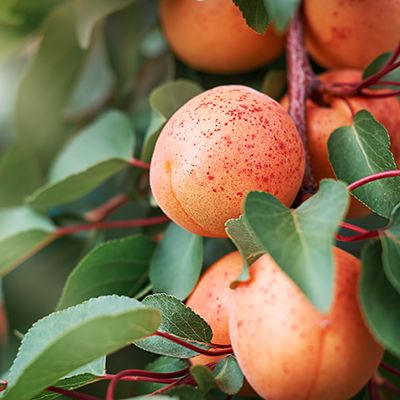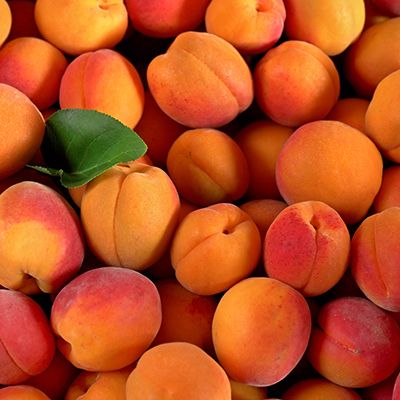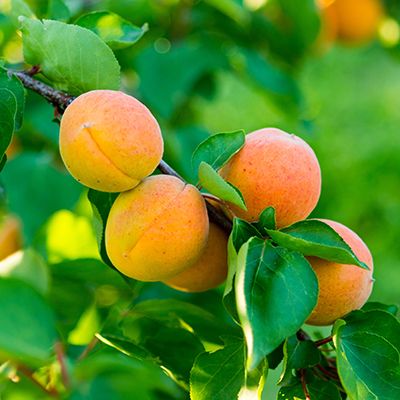Apricot Trees



Prune: Apricots may be divided into three classes according to their fruit producing habits. In all cases, the majority of the fruit is born on one year old wood (last year’s growth). Fruit may appear towards the tips of this growth, in the central section or in the lower section. The fruiting habit of your tree may be ascertained by noting where the fattest buds are located on the one year old branches. The fattest or fullest buds are the flower producing buds and indicate where the fruit will be set. The more slender buds will produce leaves and branch growth only.
In the case of the fruit buds being borne on the tip section as is found in the Royal varieties do not head back the one year branches. In the case of the best fruit buds being in the in the central section, the one year growth may be headed back about one-third. In the case of the fruit buds being in the lower branch section, the one year wood may be headed back from one-half to two-thirds of their length.
The first type will apply in most cases.
Spray: Dormant spray in December or January. Use Master Nursery® Pest Fighter Year-Round Spray Oil mixed with Monterey Liqui-Cop®. Follow label directions for appropriate quantities; usually about two tablespoons of Monterey Liqui-Cop® mixed with eight tablespoons of Master Nursery® Pest Fighter Year-Round Spray Oil in one gallon of water. Always check with your nursery professional to properly diagnose problems before undertaking additional sprays. NEVER use sulfur sprays on apricots.
SHOT HOLE:
Note: If symptoms of this disease appeared last year, spray as indicated below in addition to the winter dormant spray.
Shot Hole appears as numerous to many small holes in the leaves. Holes range in size from one-sixteenth to one-quarter of an inch in diameter. Spray after leaves fall and twice more before bud swell. Use Monterey Liqui-Cop® or Bonide® Fung-onil™.
Brown Rot or Blossom Blight – (Different names for the same disease.)
Brown rot is the most common and serious blossom and fruit disease of stone fruits. The first symptom is the browning and wilting of blossoms which may cling to the twigs for a long time. Cankers (sunken brown areas often develop at the base of the infected flowers. Sticky amber colored gum oozes from the base of the flowers or from the cankers. Prune and remove all diseased parts. The dormant season spray of horticultural oil and Monterey Liqui- Cop® should control the disease.
Bacterial canker, or bacterial gummosis, or bacterial blast (different names for the same disease) is common and deadly and caused by Pseudomonas syringae. During the fall, winter and spring, the thin bark of young trees may appear nearly black and a clear, resinous gum exudes from cankers. In older trees, gumming may exude from many areas of the bark and extend up into the small branches often killing them. Splashing rain spreads the bacteria to dormant buds, twigs and branches. Infected blossoms turn brown and wilt; some leaf and flower buds may die. Other branches may fail to produce foliage and later die. The best treatment is to spray the entire tree with Monterey Liqui-Cop® with four tablespoons per gallon of water while it is dormant. Otherwise, removal of infected wood and flowers is the only treatment.
Sanitation: Remove and destroy affected buds and blossoms during bloom. Remove and destroy maturing fruit when symptoms appear. In August or September, remove and destroy mummies and fallen fruit. Do not compost.
Fruit Thinning: See below—Fruit Thinning. Thinning fruit reduces spread of brown rot spores among fruits.
Pruning: Prune to allow good ventilation. Remove infected twigs, infected fruiting wood and infected branches. Do not compost.
Irrigation Methods: Use basin or drip irrigation to avoid wetting blossoms, foliage and fruit. (See our Peach and Nectarine Care Guide.)
Fertilize: Use Master Nursery® Fruit Tree and Vine Food twice a year, around Memorial Day and Labor Day. If you prefer organic fertilizers, use Gardner & Bloome® Citrus & Fruit Tree Fertilizer two to three weeks earlier. Supplement all organic fertilizers with iron sulfate if tree has chlorosis. Water all fertilizers in immediately after application.
Water: At planting, construct a soil berm at the drip line of the tree. As the tree matures, extend the berm to the span of the drip line. Flood weekly during the first year and then at two to four week intervals when the tree is mature. If a drip system is used, place hosing along the tree’s drip line with emitters on 12 to 16 inch centers. This system will also need to be adjusted as the drip line expands. Both flood and drip irrigation is preferable to sprinkler, since they reduce water splash, a common byway of fungal spores. If sprinklers must be used, adjust the heads so that they angle water low and away from the trunk. Keep in mind that a large, mature tree may consume up to 30 gallons of water per week in July and August and September. Start irrigating your tree(s) by mid-May or June.
Fruit Thinning: Thin fruit when it reaches one inch in diameter. Leave two inches between fruits. Thinning is especially important if the tree is infected by brown rot.
Other Comments: Watch for dieback of twigs and fruiting spurs and oozing, amber-colored gum on branches. These may be symptoms of (1) bacterial blast or (2) brown rot. Clear gum is usually not serious. Sudden limb death during summer heat could be (3) Eutypa dieback. Currently, no controls exist for Eutypa, but summer pruning allows wood to callus internally before rains begin, at which time disease spores are most prolific.
A grey-brown to black soft spot may rarely occur on the blossom end of tree fruit (green rot, blossom rot). Remove any old, dead, non-woody growth; prune to open up and let more air and light through; pick up and destroy all diseased leaves and fruit. Spray with Monterey Liqui-Cop®, (three tablespoons per gallon of water) at seven to 14 day intervals at the flower bud stage, the full bloom stage, and at petal fall. When pruning, be sure to destroy all affected wood. Bring several leaf and twig samples to Wegman’s Nursery for evaluation whenever these or other symptoms appear.
Paint trunks and lower branches of young or non-vigorous trees with a one to one mixture of white interior latex paint and water to prevent sunburn injury and reduce subsequent borer infestations. Apply the paint mixture from two inches below the soil surface to 3 feet above or to the scaffold branches.
Adapted from Ogawa and English (1991), Diseases of Temperate Zone Tree Fruit & Nut Crops, UC Extension Publication 3345; and from Flint (1998), Pests of the Garden and Small Farm, 2nd Edition, UC Extension Publication 3332.